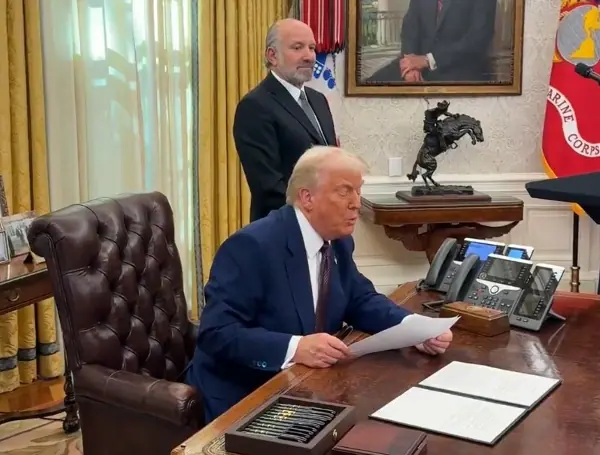President Donald Trump has signed an executive order introducing the “Fair and Reciprocal Plan,” a sweeping trade policy aimed at reducing the U.S. trade deficit and addressing what he describes as unfair trade practices by foreign partners.
The plan, which includes imposing reciprocal tariffs on imports, seeks to level the playing field for American workers, manufacturers, and businesses by ensuring that the U.S. charges the same tariffs on foreign goods as those countries charge on American exports.
READ: Trump Announces Reciprocal Tariff Plan To Address Trade ‘Fairness’
The order, signed on Thursday, outlines a comprehensive strategy to counter non-reciprocal trade arrangements and restore balance to the U.S. trade relationship with its global partners.
The executive order highlights the United States’ historically open economy and low average tariff rates compared to other major economies. Despite this openness, the U.S. has faced persistent trade deficits, which the administration argues are the result of unfair practices by trading partners.
“Our workers and industries bear the brunt of unfair practices and limited access to foreign markets,” the order states. “This situation is untenable. The trade deficit of the United States threatens our economic and national security, has hollowed out our industrial base, and has made our Nation dependent on other countries to meet our key security needs.”
The administration contends that by making trade more reciprocal and balanced, the U.S. can reduce its trade deficit, grow the economy, and improve trade relationships to the benefit of American workers, manufacturers, farmers, ranchers, entrepreneurs, and businesses.
READ: CNN’s Harry Enten Warns Trump Could Lose Popularity If He Doesn’t Fix This Key Issue
The “Fair and Reciprocal Plan” focuses on addressing non-reciprocal trade arrangements through a multi-faceted approach.
Key elements include:
- Reciprocal Tariffs: The U.S. will determine and impose tariffs equivalent to those charged by trading partners on American goods. This includes tariffs, unfair taxes, and other barriers that disadvantage U.S. businesses and workers.
- Non-Tariff Barriers: The plan will target nontariff barriers, such as regulatory requirements, subsidies, and intellectual property violations, that impede U.S. market access and competitiveness.
- Exchange Rate Manipulation: The administration will address policies and practices that cause exchange rates to deviate from their market value, wage suppression, and other mercantilist policies that harm U.S. businesses and workers.
- Comprehensive Fairness: The plan will ensure fairness by factoring in all forms of unfair trade practices, whether written or unwritten, that disadvantage the U.S.
The executive order directs the Secretary of Commerce and the United States Trade Representative (USTR), in consultation with other key officials, to investigate the harm caused by non-reciprocal trade arrangements and propose remedies to achieve reciprocal trade relations.
Within 180 days, the Director of the Office of Management and Budget (OMB) is required to assess the fiscal impacts of the plan on the federal government and the public, and deliver a written report to the President.
Definitions and Scope
The order defines key terms, including:
- Value-Added Tax (VAT): A consumption tax levied on the incremental increase in value of a good or service at each stage of the supply chain.
- Nontariff Barriers: Government-imposed measures or policies that restrict international trade, such as import policies, technical barriers, and lack of intellectual property protection.
“Nobody knows what that number is unless you go by the individual country,” Trump said. “You can see what it is if you go to the individual country and look at what they’re charging us. In almost all cases, they’re charging vastly more than we charge them. But those days are over.”
READ: CNN’s Scott Jennings Pokes Fun At AP For Being Barred From Oval Office, Not Living ‘In Reality’
The “Fair and Reciprocal Plan” marks a significant shift in U.S. trade policy, with the potential to reshape global trade dynamics.
As the administration begins implementing the plan, stakeholders will closely monitor its impact on the economy, trade relationships, and American industries.
Please make a small donation to the Tampa Free Press to help sustain independent journalism. Your contribution enables us to continue delivering high-quality, local, and national news coverage.
Connect with us: Follow the Tampa Free Press on Facebook and Twitter for breaking news and updates.
Sign up: Subscribe to our free newsletter for a curated selection of top stories delivered straight to your inbox.

